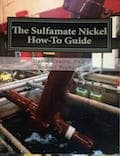
Curated with aloha by
Ted Mooney, P.E. RET

The authoritative public forum
for Metal Finishing 1989-2025

-----
Peel off in between bright nickel and semi bright nickel layer
Current question and answers:
Q. Dear sir,
I am a plating supervisor. I am facing peel off problem from semi-bright nickel. pH maintenance as per Coventya team 3.8-4.2 . Please sir some suggestions for me this time.
- YAMUNA NAGAR, India
February 22, 2021
A. If there is another part being plated in the bright nickel, then when you enter the second part (with it's semi-bright), during the time before contact is made, the galvanic current passivates the semi=bright and then the bright nickel peels. Make contact externally before entering the bright tank.

Robert H Probert
Robert H Probert Technical Services
Garner, North Carolina

February 23, 2021
A. PRABHJOT SINGH,
Peeling semi bright nickel to bright nickel, check:
1) Rectifier amps and voltage & all contacts
2) May be over loaded brightener in bath
3) Faster move of rack from semi bright to bright nickel; if longer time in air, nickel passivates.
4) Run hull cell panels bright and semi-bright nickel
5) Carbon treat semi-bright and bright nickel bath.

Popatbhai B. Patel
electroplating consultant - Roseville, Michigan
March 4, 2021
A. Hi PRABHJOT,
Please check the Metallic impurities and Organic brightener level by Instrument Method (by Hull cell method also). If it's found any impurities level, please run a Dummy plate and carbon in the bath.
- Bangalore, Karnataka , India
March 9, 2021
⇩ Related postings, oldest first ⇩
Q. I'm facing peel off problem in duplex nickel( peel of in between bright and semi bright nickel layer), the percentage of peel off is in PPM but even though its not acceptable. what may be the probable reason for this?generally this problem is seen in one particular component only. if we treated the semi bright solution next 2-3 days there is no peel of observed but it arises again after 3-4 days and daily we face problem in 4-8 pieces. Is this due to brightener chemistry? What brightener base shall we try to over come such problem? Or it may be mechanical problem?please advise.
Milind VaradkarPlating plant - Mumbai, India
2006
A. Please give full bath and process specifications. What is your brightener and any other additives. Then we may be able to help

Trevor Crichton
R&D practical scientist
Chesham, Bucks, UK
2006
A. You did not give the sequence so I have not much details but anyhow remember that you should NOT rinse between the semi and the bright nickel.

Sara Michaeli
Tel-Aviv-Yafo, Israel
2006
A. To clarify your statement, your reject rate is in ppm(parts per million). You must have plated one million pieces before you observed the problem?
Organic brighteners have breakdown by-products during use.
Oxidation in the anode area, reductions in the cathode.
Why not give the semi-bright nickel the treatment after a day and a half of use?
- Mays Landing, New Jersey
2006
|
|
A. Dear Mr. Milind,  Vishwas Nangare motorcycle accessories mfgr. - Aurangabad, Maharashtra, India 2007 A. Dear Mr. Varadkar, - Jakarta, Indonesia 2007 |
A. Mr. Milind,
Let me give you another window to look at since I have spent 4 years in Sonepat running a duplex nickel line.
You say that if you treat the bath the problem goes away but comes back in 2 days or so. That tells me that you have cross contamination from the adjoining bright nickel tanks. If I am right then you are going in semi-bright and then immediate next tank is bright nickel.
The additives you use in the bright nickel have sulfur in them whereas there is no sulfur in the semi bright bath. So make sure that first, no one is mixing the additives, and second there is no cross contamination of bright solution into semi bright solution.
Check your filters also. Make sure no one is switching the filters between the two tanks.
Another thing, when you have done plating in bright tank then the rack should not cross over the semi-bright tank because it will give you cross contamination through falling solution. This means your semi bright tank should be at farther end and then as you are coming back towards unloading side, you are dipping/plating in the bright tank. I hope I have make myself clear enough!
Another way for just to detect the problem is STEP test. It will tell you the difference between the semi bright and bright layers. Why don't you compare layers of bright and semi bright on the parts, which have peel off problem. If there is not a big difference in the curve that will indicate that semi bright layer is slightly becoming a bright layer ... due to addition of sulfur based products in its chemistry...
VERY IMPORTANT THING MAN....you said you are rejecting only in PPM....are you sure about that ... I won't even do anything if my rejection level is at that level. Usually 3% level of rejection is considered optimum in plating shops...
Good luck...

Hemant Kumar
- Florida, USA
Q, A, or Comment on THIS thread -or- Start a NEW Thread
